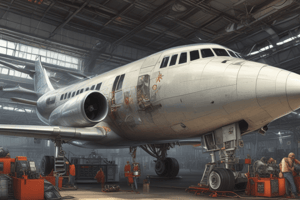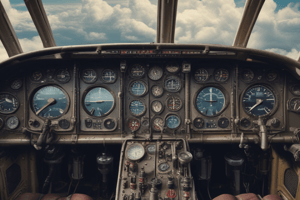Podcast
Questions and Answers
What type of records must be retained for a specified period, such as 5 years, for regulatory compliance and auditing purposes?
What type of records must be retained for a specified period, such as 5 years, for regulatory compliance and auditing purposes?
- Emergency procedure manuals
- Repair documentation
- Maintenance records (correct)
- PPE inventory records
What is the primary purpose of lockout/tagout procedures in an aircraft maintenance setting?
What is the primary purpose of lockout/tagout procedures in an aircraft maintenance setting?
- To document all maintenance activities
- To prevent accidental startup of systems or equipment (correct)
- To ensure proper use and maintenance of PPE
- To conduct inspections and testing to ensure airworthiness
What is a critical aspect of emergency procedures in aircraft maintenance?
What is a critical aspect of emergency procedures in aircraft maintenance?
- Conducting regular inspections
- Fire response and spill response (correct)
- Using approved materials and parts
- Documenting all maintenance activities
What category of repair requires specialized skills and equipment?
What category of repair requires specialized skills and equipment?
What is a requirement for electronic records in aircraft maintenance?
What is a requirement for electronic records in aircraft maintenance?
What is a critical aspect of repair documentation in aircraft maintenance?
What is a critical aspect of repair documentation in aircraft maintenance?
What type of inspection is typically conducted after each flight?
What type of inspection is typically conducted after each flight?
Which of the following is NOT a type of inspection technique?
Which of the following is NOT a type of inspection technique?
What is the primary purpose of quality control checks?
What is the primary purpose of quality control checks?
What is the main responsibility of quality control personnel?
What is the main responsibility of quality control personnel?
What is the primary goal of hazard identification and risk assessment?
What is the primary goal of hazard identification and risk assessment?
What is the purpose of reviewing maintenance records?
What is the purpose of reviewing maintenance records?
Study Notes
Aircraft Inspection
- Types of inspections:
- Pre-flight inspections: visual checks before each flight
- Post-flight inspections: checks after each flight
- Scheduled inspections: routine checks at set intervals (e.g. daily, weekly, monthly)
- Annual inspections: comprehensive checks required by regulatory authorities
- Inspection areas:
- Airframe and structural components
- Engines and engine components
- Avionics and electrical systems
- Propellers and propeller systems
- Landing gear and brakes
- Inspection techniques:
- Visual examinations
- Functional tests
- Measurement and testing
- Non-destructive testing (e.g. X-ray, ultrasound)
Quality Control
- Purpose: to ensure maintenance work meets specified standards
- Quality control checks:
- Review of maintenance records
- Inspection of completed work
- Verification of parts and materials
- Testing of systems and components
- Quality control personnel:
- Responsible for conducting quality control checks
- Ensure compliance with regulatory requirements
- Identify and report discrepancies
Safety Protocols
- Hazard identification and risk assessment:
- Identify potential hazards in the maintenance environment
- Assess the risk of injury or damage
- Implement measures to mitigate or eliminate hazards
- Personal protective equipment (PPE):
- Required for certain tasks (e.g. welding, chemical handling)
- Ensure proper use and maintenance of PPE
- Lockout/tagout procedures:
- Prevent accidental startup of systems or equipment
- Ensure proper isolation and de-energization
- Emergency procedures:
- Fire response
- Spill response
- First aid and medical response
Record Keeping
- Maintenance records:
- Document all maintenance activities
- Include details of work performed, parts replaced, and inspections conducted
- Required for regulatory compliance and auditing purposes
- Record retention:
- Maintenance records must be retained for a specified period (e.g. 5 years)
- Records must be accurate, complete, and legible
- Electronic records:
- Allowed by regulatory authorities
- Must meet specific requirements for security, accessibility, and backup
Repair Procedures
- Repair categories:
- Minor repairs: routine maintenance tasks (e.g. replacing light bulbs)
- Major repairs: complex tasks requiring specialized skills and equipment
- Repair procedures:
- Follow approved data (e.g. manufacturer's instructions)
- Use approved materials and parts
- Conduct inspections and testing to ensure airworthiness
- Repair documentation:
- Document all repairs and modifications
- Include details of work performed, parts replaced, and inspections conducted
Aircraft Inspection
- Various types of inspections are conducted on aircraft, including pre-flight, post-flight, scheduled, and annual inspections.
- Inspections cover critical areas, including airframe and structural components, engines, avionics, propellers, and landing gear.
- Inspection techniques involve visual examinations, functional tests, measurement and testing, and non-destructive testing methods like X-ray and ultrasound.
Quality Control
- Quality control ensures maintenance work meets specified standards, and is critical for ensuring airworthiness.
- Quality control checks involve reviewing maintenance records, inspecting completed work, verifying parts and materials, and testing systems and components.
- Quality control personnel are responsible for conducting checks, ensuring compliance with regulatory requirements, and identifying and reporting discrepancies.
Safety Protocols
- Hazard identification and risk assessment are crucial for identifying potential hazards in the maintenance environment and mitigating or eliminating them.
- Personal protective equipment (PPE) is required for certain tasks, and its proper use and maintenance are essential.
- Lockout/tagout procedures prevent accidental startup of systems or equipment, and ensure proper isolation and de-energization.
- Emergency procedures are in place for fire response, spill response, and first aid and medical response.
Record Keeping
- Maintenance records document all maintenance activities, including work performed, parts replaced, and inspections conducted.
- Records must be retained for a specified period, typically 5 years, and must be accurate, complete, and legible.
- Electronic records are allowed, but must meet specific requirements for security, accessibility, and backup.
Repair Procedures
- Repairs are categorized into minor and major repairs, with minor repairs including routine maintenance tasks and major repairs requiring specialized skills and equipment.
- Repair procedures involve following approved data, using approved materials and parts, and conducting inspections and testing to ensure airworthiness.
- Repair documentation is critical, and includes details of work performed, parts replaced, and inspections conducted.
Studying That Suits You
Use AI to generate personalized quizzes and flashcards to suit your learning preferences.
Description
Test your knowledge of different types of aircraft inspections, including pre-flight, post-flight, scheduled, and annual inspections, and the various areas that are inspected, such as airframe and engines.



